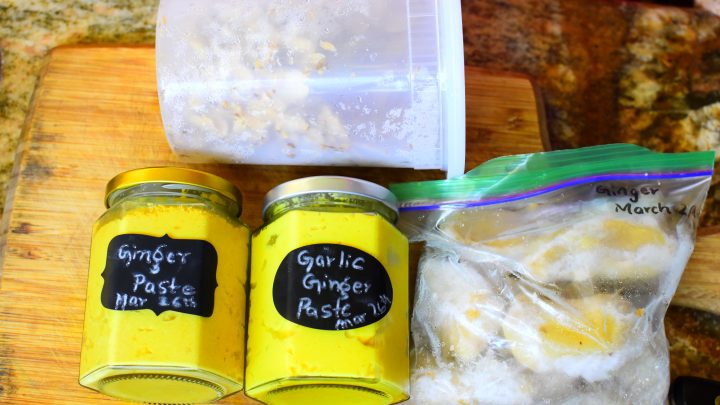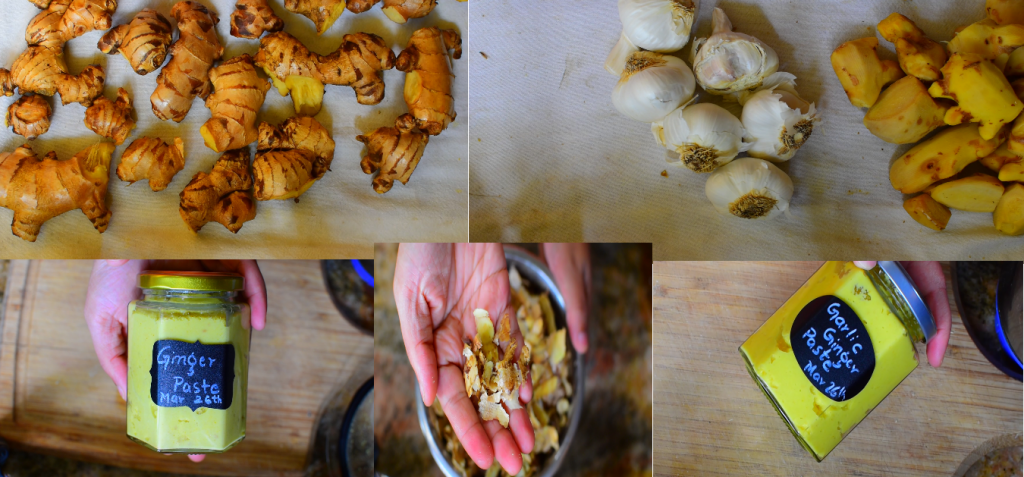Ginger has a very long history of use in various forms of traditional / ayurvedic medicine. It has been used to help digestion, reduce nausea and help fight the flu and common cold, to name a few.
Ginger can be used fresh, dried, powdered, or as an oil or juice, and also used in desserts and candies. It is a very common ingredient in indian recipes.
The unique fragrance and flavor of ginger comes from its natural oils, the most important of which is gingerol. It has powerful anti-inflammatory and antioxidant effects.These active compounds in ginger keep oral bacteria from growing.
They help our body fight off chronic diseases like high blood pressure, heart disease, and diseases of the lungs, plus promote healthy aging.
Ginger is one of the very few “SUPERFOODS” actually worthy of that term. Sure growing ginger at home is a great experience.But,we can buy fresh ginger at a local grocery store anytime.
Garlic is a plant in the onion family that is grown for its distinctive taste and health benefits.
Garlic contains sulfur compounds, which are believed to bring some of the health benefits. The sulfur compounds from garlic enter the body from the digestive tract and travel all over the body, where it exerts its potent biological effects.
Garlic is low in calories and rich in vitamin C, vitamin B6, and manganese. Garlic contains antioxidants that protect against cell damage and aging.
The fact that it can fight infectious disease is also an important factor, because these are common causes of death, especially in the elderly or people with dysfunctional immune systems. So it makes Garlic one of the “SUPERFOODS“!
Garlic is very easy (and delicious) to include in our diet. It complements most savory dishes, particularly soups and sauces. The strong taste of garlic can also add a punch to otherwise bland recipes.
Both ginger and garlic are known for their natural, antibacterial characteristics, and their ability to relieve congestion and loosen phlegm. So, ginger relieves congestion, softens aching muscles, and can soothe a sore throat. Garlic is considered to be an antibiotic and is often recommended for treating flu and colds.
Here is a buying guide to buy good quality Ginger-Garlic:
- Choose ginger that’s firm to the touch, smooth, and relatively free of blemishes. Wrinkly skin would indicate it’s been sitting there, dehydrating for a while.
- The ginger skin should be thin — never thick and fibrous.
- Young ginger is ginger harvested about halfway through the growing cycle. Its skin is tinged pink and it’s thinner and paler than mature ginger—no need even to peel it. It has a mild, delicate flavor, as you might expect.[Asian markets and farmers’ markets in late summer and early fall are where you’ll most likely find young ginger].
- A bulb of garlic may contain eight cloves, or as many as 40. Choose a bulb with large cloves if you’re a garlic lover.
- Look for garlic sold loose, so you can choose a healthy, solid bulb.
- At the market, look for garlic with a very firm head. Avoid bulbs that are dried out or have soft spots or mold. Green shoots in a bulb are a sign of internal growth in the clove; it’s an indication of old garlic. And as with other produce, bigger doesn’t necessarily mean better. Varieties vary in size, and many people find that a smaller bulb of garlic has more flavor than a larger one.
Storing Ginger & Garlic Fresh For A Long Time | Ginger Garlic Paste

Materials
- Ginger
- Garlic
- Turmeric
- Salt
- Oil
Tools
- Mixer Jar
- Spatula
- Clean Sterile Glass Jars

